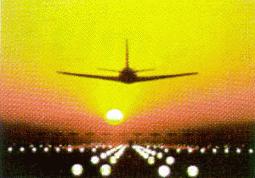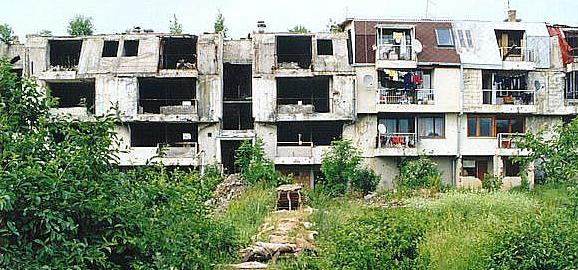Today it is, just partly, the last Sarajevo station on the way to Serb entity. The neighborhood is settled between Mojmilo hill, former Yugoslav Army barracks in Lukavica, Sarajevo airport and area Nedjarici, the surrounding which was lethal to war life of Dobrinja and its inhabitants and it is divided by river Dobrinja that settlement was named after. Now Dobrinja is divided by something else, not so physical. Republika Srpska and Federation have their border line here. There are two ways of coming to the area. Coming from the airport or from Nedjarici, which is more common. As we enter Dobrinja, the destroyed buildings greet us. Presentation is about to begin.
 The first phase of building the area was finished in 1983. The year when Dobrinja 1 and 2 were built, its buildings gave home to new citizens, and for the short time, to participants of the 14 Winter Olympic Games. Two big blocks, one school and trolleys connection to the city would be the basic structure of the area at the time. Soon, another school would be joined to this picture, and after that Dobrinja 3 also. The new school and another two blocks, Dobrinja 4 and 5, were built and moved into just before the war. And to make things tragic, these two blocks suffered the biggest destruction during the war. All three schools were destroyed. Abandoned and ruined, they gave a sad tone to Dobrinjas’ silence. Dobrinja 4 and some parts of Dobrinja 1 are part of the Serb entity today. The war made borders, borders divided people.
The first phase of building the area was finished in 1983. The year when Dobrinja 1 and 2 were built, its buildings gave home to new citizens, and for the short time, to participants of the 14 Winter Olympic Games. Two big blocks, one school and trolleys connection to the city would be the basic structure of the area at the time. Soon, another school would be joined to this picture, and after that Dobrinja 3 also. The new school and another two blocks, Dobrinja 4 and 5, were built and moved into just before the war. And to make things tragic, these two blocks suffered the biggest destruction during the war. All three schools were destroyed. Abandoned and ruined, they gave a sad tone to Dobrinjas’ silence. Dobrinja 4 and some parts of Dobrinja 1 are part of the Serb entity today. The war made borders, borders divided people.
Before the war, somebody called Dobrinja the towns biggest dormitory. And indeed it was. Life would vanish with first dark fall, and only children could be heard on the streets. Cultural and social life was something abstract at that time. Things are not much better even today, but according to the
pre - war period, youth of Dobrinja can find entertainment in several disco clubs and many cafe’s.
The Euroclub is opened for concert activities of rock bands. There will be concerts of few Croatian and two Bosnian bands in May. There is no cinema. Elders spend their free time participating in work of several cultural societies existing here. Something is changing after all. There is a notification about building business centers and space for cultural education. We hope so.
Sarajevo war mornings woke up Dobrinja with barricades and shootings. The war had begun. The area was exposed to artillery fire for over three years. Many inhabitants did not live to see the peace. Improvised graveyards testify that. General devastation, starvation, poverty … were picture’s that traveled around world for four years, and they were taken in Dobrinja. Citizens survived thanks to humanitarian aid which came from the airport. They survived thanks to their patience. And faith. In 1993, inhabitants made gardens and planted vegetables on grass surface. Their aim was survival.
The gardens are gone today, but so is the grass. Only traces of burned ground are visible today.
Dobrinja hospital was created in the war. The institution which had saved thousands of lives, working day and night. Made out of nothing, with persistence and enthusiasm of employees, it was brought to a level when complicated operations could be done. Today, some people suggest it should be closed, with an excuse that there is no longer a reason for its existence.
Where there were 40.000, today in Dobrinja we have only the half number of pre - war citizens. Many of them have left their community, city, country …searching for a better and safer life. Many were forced to leave. There is a great number of refugees in Dobrinja. It was the first station on their way to Sarajevo. Streets are dirty and often covered with garbage. Ruined street lights give the area spooky sight at night. We can only see the silhouettes of people walking by.
But still, the signs of renovation can be seen. One school has been renovated and gives shelter to pupils, instead of war basements. Another school is being rebuilt. Old ruins are getting a new, more beautiful appearance. Parks for children are being decorated, new buildings are rising. International community has announced that there would be donations for reconstruction of entire blocks. Dobrinja dark is beginning to look brighter. We look forward to it.

